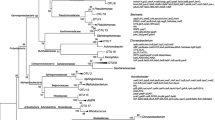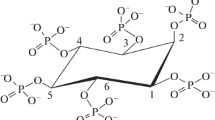Abstract
Microbial phytases play a major role in the mineralization of organic phosphorous, especially in symbiotic plants and animals. In this study, we identified two types of phytases in Serratia sp. TN49 that was harbored in the gut of Batocera horsfieldi (Coleoptera) larvae. The two phytases, an acidic histidine acid phosphatase (PhyH49) and an alkaline β-propeller phytase (PhyB49), shared low identities with known phytases (61% at most). PhyH49 and PhyB49 produced in Escherichia coli exhibited maximal activities at pH 5.0 (60°C) and pH 7.5–8.0 (45°C), respectively, and are complementary in phytate degradation over the pH range 2.0–9.0. Serratia sp. TN49 harboring both PhyH49 and PhyB49 might make it more adaptive to environment change, corresponding to the evolution trend of microorganism.





Similar content being viewed by others
References
Cheng C, Lim B (2006) β-Propeller phytases in the aquatic environment. Arch Microbiol 185:1–13
Devillard E, Newbold CJ, Scott KP et al (1999) A xylanase produced by the rumen anaerobic protozoan Polyplastron multivesiculatum shows close sequence similarity to family 11 xylanases from Gram–positive bacteria. FEMS Microbiol Lett 181:145–152
Dillon R, Dillon V (2004) The gut bacteria of insects: nonpathogenic interactions. Ann Rev Entomol 49:71–92
Fu S, Sun J, Qian L, Li Z (2008) Bacillus phytases: present scenario and future perspectives. Appl Biochem Biophys 151:1–8
Garcia-Vallve S, Romeu A, Palau J (2000) Horizontal gene transfer of glycosyl hydrolases of the rumen fungi. Mol Biol Evol 17:352–361
Greiner R, Konietzny U, Jany KD (1993) Purification and characterization of two phytases from Escherichia coli. Arch Biochem Biophys 303:107–113
Huang H, Luo H, Yang P et al (2006) A novel phytase with preferable characteristics from Yersinia intermedia. Biochem Biophys Res Commun 350:884–889
Huang H, Shi P, Wang Y et al (2009) Diversity of β-propeller phytase genes in the intestinal contents of grass carp provides insight into the release of major phosphorus from phytate in nature. Appl Environ Microbiol 75:1508–1516
Huang H, Shao N, Wang Y et al (2009) A novel beta-propeller phytase from Pedobacter nyackensis MJ11 CGMCC 2503 with potential as an aquatic feed additive. Appl Microbiol Biotechnol 83:249–259
Huang H, Zhang R, Fu D et al (2010) Diversity, abundance and characterization of ruminal cysteine phytases suggest their important role in phytate degradation. Environ Microbiol 13:747–757
Jorquera M, Martinez O, Maruyama F et al (2008) Current and future biotechnological applications of bacterial phytases and phytase-producing bacteria. Microb Environ 23:182–191
Lim B, Yeung P, Cheng C, Hill J (2007) Distribution and diversity of phytate-mineralizing bacteria. ISME J 1:321–330
Mullaney E, Ullah A (2003) The term phytase comprises several different classes of enzymes. Biochem Biophys Res Commun 312:179–184
Oh BC, Choi WC, Park S, Kim YO, Oh TK (2004) Biochemical properties and substrate specificities of alkaline and histidine acid phytases. Appl Microbiol Biotechnol 63:362–372
Sajidan A, Farouk A, Greiner R et al (2004) Molecular and physiological characterisation of a 3-phytase from soil bacterium Klebsiella sp. ASR1. Appl Microbiol Biotechnol 65:110–118
Schloss PD, Delalibera I, Handelsman J, Raffa KF (2006) Bacteria associated with the guts of two wood-boring beetles: Anoplophora glabripennis and Saperda vestita (Cerambycidae). Environ Entomol 35:625–629
Shedova E, Lipasova V, Velikodvorskaya G et al (2008) Phytase activity and its regulation in a rhizospheric strain of Serratia plymuthica. Folia Microbiol (Praha) 53:110–114
Timmis KN (2002) Pseudomonas putida: a cosmopolitan opportunist par excellence. Environ Microbiol 4:779–781
Turner BL, Papházy MJ, Haygarth PM, McKelvie ID (2002) Inositol phosphates in the environment. Philos Trans R Soc Lond B Biol Sci 357:449–469
Watanabe K, Sato M (1998) Plasmid-mediated gene transfer between insect-resident bacteria, Enterobacter cloacae, and plant-epiphytic bacteria, Erwinia herbicola, in guts of silkworm larvae. Curr Microbiol 37:352–355
Wodzinski R, Ullah A (1996) Phytase. Adv Appl Microbiol 42:263–302
Zhou J, Zhang R, Shi P et al (2011) A novel low-temperature-active β-glucosidase from symbiotic Serratia sp. TN49 reveals four essential positions for substrate accommodation. Appl Microbiol Biotechnol. doi:10.1007/s00253-011-3323-2
Acknowledgment
This research was supported by the National Natural Science Foundation of China (31001025) and the China Modern Agriculture Research System (CARS-42).
Author information
Authors and Affiliations
Corresponding author
Rights and permissions
About this article
Cite this article
Zhang, R., Yang, P., Huang, H. et al. Two Types of Phytases (Histidine Acid Phytase and β-Propeller Phytase) in Serratia sp. TN49 from the Gut of Batocera horsfieldi (Coleoptera) Larvae. Curr Microbiol 63, 408 (2011). https://doi.org/10.1007/s00284-011-9995-0
Received:
Accepted:
Published:
DOI: https://doi.org/10.1007/s00284-011-9995-0




